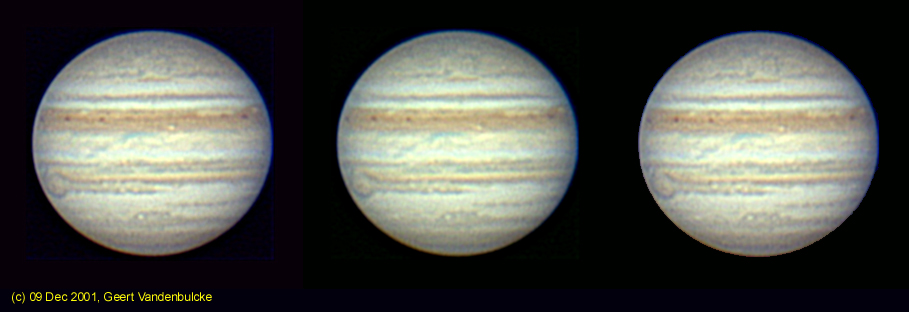
Jupiter 2000 - 2001
09-10 December 2001, emergence of the GRS.
Philips ToUcam images of Jupiter made with a Celestron 14 SCT + barlow (f/22), around 00:00 UTC.
Software used: Philips original ToUcam capture software + Avi2Bmp + Photoshop.

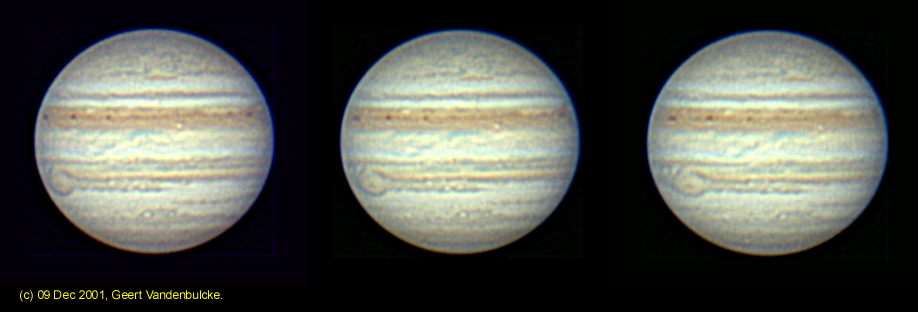
a GIF animation of these 6 images and an image of Europe and Ganymede :
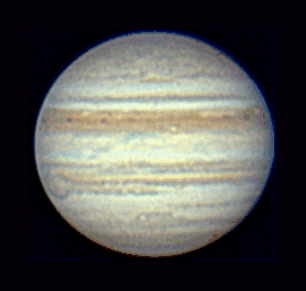
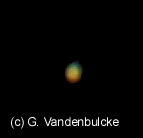
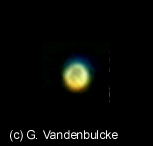
After the ToUcam session, I decided to try the R(G)B technique with my SBIG ST-8 CCD camera. A series of 10 Red images and 10 Blue images were made. More was not possible because of the long download time for the images, which have to be taken within one minute. These images were averaged for Red and Blue. The Red and Blue Master images were averaged with each other to obtain an artificial Green image. The image was then further processed in AstroArt and Photoshop:
B.jpg)
30 October 2001.
An image of Jupiter made with a Celestron 14 SCT with a barlow (f/22), during the morning hours (between 03:30 and 04:00 UTC).
The left image is the best single image out of an avi stack of 487 images made with a Philips ToUcam Pro. The image to the right is the kappa-sigma combination of the 9 best images of the avi file.
Software used: Philips original ToUcam capture software + Avi2Bmp + Photoshop.
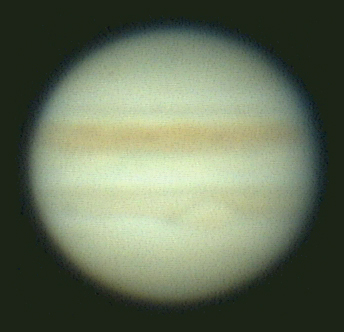

14 October 2001.
Two images of Jupiter made with a Celestron 14 SCT, during the morning hours of 14 Oct.
The left image with a 120 mm off-axis mask giving a f/32 focus, combined from a selection of 70 images out of 500 with a Philips ToUcam Pro webcam.
The right image at full 356 mm aperture + 2x barlow giving a f/22 focus, combined from a selection of 89 images out of 500 with a Philips ToUcam Pro webcam.
Software used: Philips original ToUcam capture software + Avi2Bmp + Photoshop. Both images resized to same size for comparison.
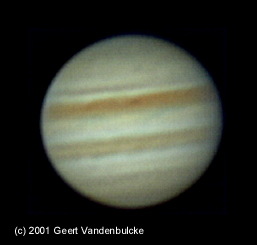

10 October 2001.
An image of Jupiter made with a Celestron 14 SCTat the f/11 focus. Selection of 20 images out of 300 made with a Philips ToUcam Pro Webcam.
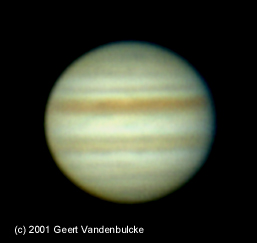
12 January 2001.
Two images made with my Opticon 250 mm f/15 SCT, using a 2x Televue Big Barlow, ST8+CFW8.
The grayscale image is composed of 5 images of 0.11 s exposure each through the clear filter. The colour image consists of one image for each colour, each 0.2 s exposure.

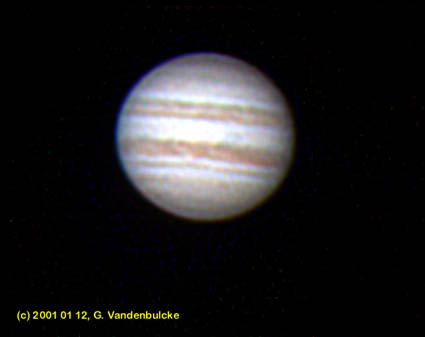
20 December 2000.
Seeing was not that good. Opticon 250 mm f/15 SCT + Televue Big Barlow + ST8 CFW8. Three RGB series were combined to form the image below left. The right image is a combination of 3 images taken through the blue filter.
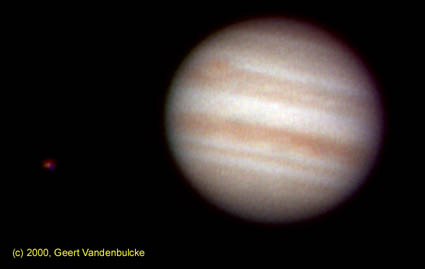

03 December 2000.
After a long period of bad weather, finally an evening with some decent astro-weather. The seeing was only average, which can be seen in the results. I used my Opticon 250 mm f/15 SCT, a Televue Big Barlow and ST-8.
The first image is made from a selection of 50 images (0.5 s) through the CFW8 blue filter. 5 images were averaged and unsharp masked.
The second image is an R(G)B image composed of a selection of blue filtered images and a selection of red filtered images. The blue and red images were then aligned and averaged, after which the green channel was synthesised out of the blue and red images. Exposures for blue were 0.5 s, for red 0.2 s.
The third image is a RGB image using the three CFW8 filters. It is composed of two blue, two green and two red images, aligned and averaged with unsharp mask processing.
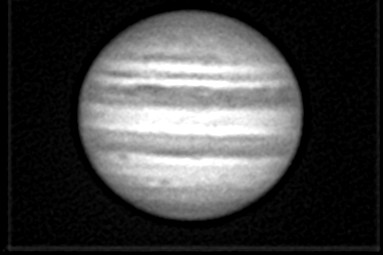
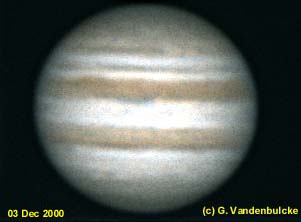
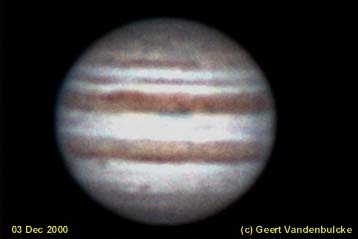
11 September 2000.
The morning of the 11th September promised to be good as transparency and seeiing was concerned. I was not deceived : after getting up at 3 a.m.I found a clear and steady but rather warm "Indian Summer" nightsky. The following images were made with my Opticon 250 mm f/15 SCT working at f/30 with a Televue barlow and my ST-8 + CFW8. All image processing was done in AstroArt, with final touches in Photoshop. The RGB components were exposed 0.5/0.5/0.75 s. The two images below are the best from 10 RGB series, each serie consisting of 10 R, G and B images.
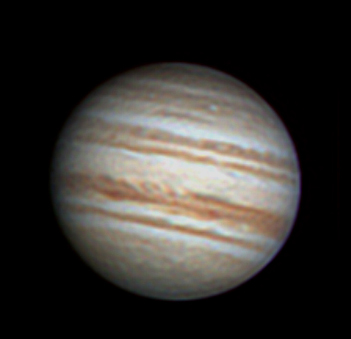

Below is a Gif animation, made up of the 10 RGB images made that morning :
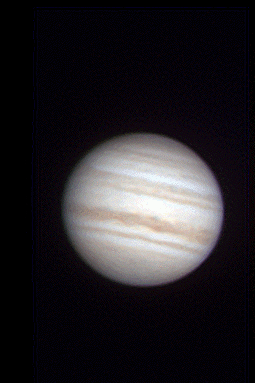
29 August 2000.
Image made on 29 August 2000 with a SBIG ST-8, Takahashi CN212 in cassegrain f/12 configuration and Televue 2x barlow. The image consists of 6 averaged 0.5 s exposures. Treated in AstroArt (selection and registering) and Prism (unsharp masking).
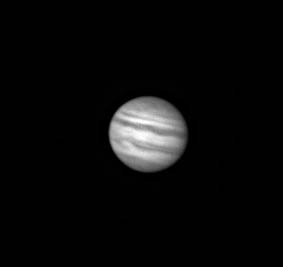
25 August 2000.
First "year 2000" Jupiter images with a ST-8 used on my Opticon 250 mm f/15 SCT and Televue 2x Barlow. Seeing only moderate.
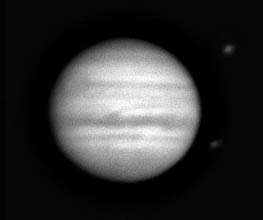
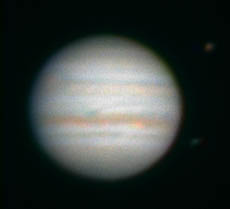
The image to the left is a single 0.11 s exposure using a clear infra red rejection filter, the image to the right is a LRGB image using the left image as the L component, R and G components were 0.11 s exposure and B component was 0.22 s exposure. Each RGB component is an average of three consecutive images. The Jovian moons are Europa and Ganymede. Image processing using AstroArt.